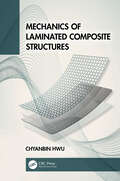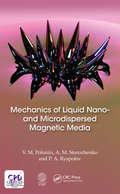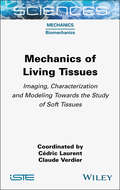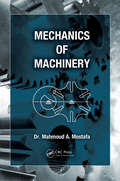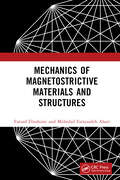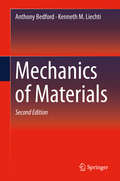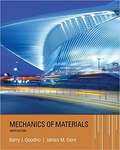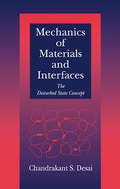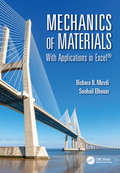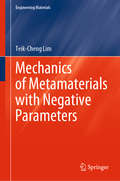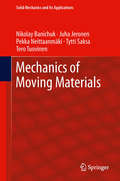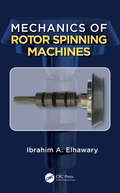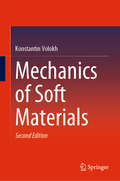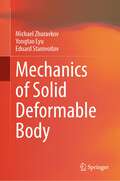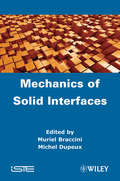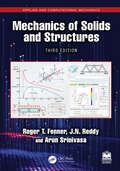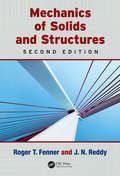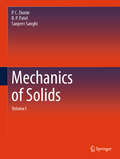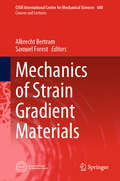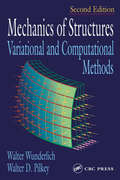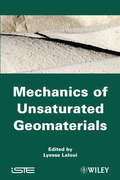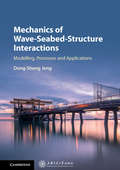- Table View
- List View
Mechanics of Laminated Composite Structures
by Chyanbin HwuIn this textbook for students of laminated composite materials, composite structures, and anisotropic elasticity, Chyanbin Hwu draws on more than three decades of research and applications experience to provide a leading resource on many unique topics related to laminated composite structures.This book introduces the mechanical behavior of laminated composite materials and provides related theories and solutions. All basic structural elements such as beams, plates, and shells are described in detail. Further contents include composite sandwich construction and composite wing structures. To connect with practical engineering applications and analyze more complicated real structures, numerical methods and their theoretical basis in anisotropic elasticity are also included. Advanced topics addressed include solutions for magneto-electro-elastic laminated plates; Green’s functions for thick laminated plates and beams; typical thick laminated beams; theory for general laminated composite shells; sandwich beams, plates, and cylindrical shells as well as delaminated composite sandwich beams; modeling and analysis of composite wing structures; complex variable theories of anisotropic elasticity and the related Green’s functions; and numerical methods such as finite element method, boundary element method and meshless method. Through this book, readers will learn not only the mechanics of laminated composite structures but also anisotropic elasticity and some popular numerical methods.This textbook is vital for advanced undergraduate and graduate students interested in the mechanics of composite materials, composite structures, and anisotropic elasticity, such as aerospace, mechanical, civil, and naval engineering; applied mechanics; and engineering science. It is also useful for engineers working in these fields and applied mathematicians and material scientists.
Mechanics of Liquid Nano- and Microdispersed Magnetic Media
by V. M. Polunin A. M. Storozhenko P.A. RyapolovThis book offers unique coverage of the mechanical properties of nano- and micro-dispersed magnetic fluids. Magnetic fluids are artificially created materials that do not exist in the nature. Researchers developing materials and devices are keenly interested in their "mutually exclusive" properties including fluidity, compressibility, and the ability to magnetize up to saturation in relatively small magnetic fields. Applications of micro- and nanodispersed magnetic fluids include magnetic-seals, magnetically operated grease in friction units and supports, separators of non-magnetic materials, oil skimmers and separators, sensors of acceleration and angle, and gap fillers in loudspeakers.
Mechanics of Living Tissues: Imaging, Characterization and Modeling Towards the Study of Soft Tissues (ISTE Invoiced)
by Claude Verdier C Dric LaurentDespite their many common features (mechanical behavior, multi-scale structure, evolutionary and living characteristics, etc.), the tissues that make up the human body each have specific characteristics linked to their function, which require the development of dedicated experimental, theoretical and numerical methods. Mechanics of Living Tissues brings together the work of a number of experts to provide an overview of the most recent approaches developed to study the biomechanical behavior of these soft tissues, in order to understand their structure and apparent behavior. Specific tissues are analyzed across the chapters with the aim of developing solutions that address the clinical problems encountered. Conclusions are then drawn regarding future methods that will improve the current state of knowledge of the behavior of these living tissues, in particular with a view to predicting the effect of a pathology or medical procedure on their apparent properties.
Mechanics of Machinery
by Mahmoud A. MostafaMechanics of Machinery describes the analysis of machines, covering both the graphical and analytical methods for examining the kinematics and dynamics of mechanisms with low and high pairs. This text, developed and updated from a version published in 1973, includes analytical analysis for all topics discussed, allowing for the use of math software
Mechanics of Magnetostrictive Materials and Structures
by Farzad Ebrahimi Mehrdad Farajzadeh AhariMechanics of Magnetostrictive Materials and Structures demonstrates the practical applications and uses for cutting-edge smart magnetostrictive materials. Exploring the analytical and numerical solution procedures and characteristics of these materials more generally, the book details how these materials respond to external factors. Exceptionally adjustable and adaptable, magnetostrictive materials are artifcial structures that offer distinctive physical properties. Providing clear illustrations throughout, this book includes a comprehensive guide to the theory and its applications. Presenting the mathematical tools needed to analyze magnetostrictive materials and structures, through the use of MATLAB®, the book will also detail static analysis. Comprehensively assessing the practicalities of these smart materials, it also discusses vibration and buckling under different loads, alongside dynamic behavior. Features: Includes MATLAB® for analytical and numerical simulations relevant to mechanics of magnetostrictive materials Presents vibration analysis of magnetostrictive materials and structures Demonstrates and analyzes the effect of implementing boundary conditions on the mechanical responses of magnetostrictive structures Examines the use of smart materials in engineering structures Aimed at students and professionals working in the field of mechanics, materials and dynamics, the book is an essential guide to this rapidly developing area.
Mechanics of Materials
by Anthony Bedford Kenneth M. LiechtiThis revised and updated second edition is designed for the first course in mechanics of materials in mechanical, civil and aerospace engineering, engineering mechanics, and general engineering curricula. It provides a review of statics, covering the topics needed to begin the study of mechanics of materials including free-body diagrams, equilibrium, trusses, frames, centroids, and distributed loads. It presents the foundations and applications of mechanics of materials with emphasis on visual analysis, using sequences of figures to explain concepts and giving detailed explanations of the proper use of free-body diagrams. The Cauchy tetrahedron argument is included, which allows determination of the normal and shear stresses on an arbitrary plane for a general state of stress. An optional chapter discusses failure and modern fracture theory, including stress intensity factors and crack growth. Thoroughly classroom tested and enhanced by student and instructor feedback, the book adopts a uniform and systematic approach to problem solving through its strategy, solution, and discussion format in examples. Motivating applications from the various engineering fields, as well as end of chapter problems, are presented throughout the book.
Mechanics of Materials
by Barry J. Goodno and James M. GereDevelop a thorough understanding of the mechanics of materials - an essential area in mechanical, civil, and structural engineering -- with the analytical approach and problem-solving emphasis in the market-leading MECHANICS OF MATERIALS, 9E. This book focuses on the analysis and design of structural members subjected to tension, compression, torsion, bending, and more. Photographs and detailed diagrams demonstrate reactive and internal forces and resulting deformations.
Mechanics of Materials and Interfaces: The Disturbed State Concept
by Chandrakant S. DesaiThe disturbed state concept (DSC) is a relatively new development and until now has lacked extensive attention in a publication. This book presents the first detailed, theoretical treatment of the DSC and shows that it can provide a unified and simplified approach for mathematical characterization of the mechanical response of materials and interfaces. The author compares the DSC with other available models, identifies the physical meaning of the relevant parameters, validates the DSC models implements the model in computer procedures, and validates those procedures by comparing predictions with observations.
Mechanics of Materials: With Applications in Excel
by Bichara B. Muvdi Souhail ElhouarMechanics of Materials: With Applications in Excel® covers the fundamentals of the mechanics of materials—or strength of materials—in a clear and easily understandable way. Each chapter explains the theory of the underlying principles and the applicable mathematical relations, offering examples that illustrate the application of the mathematical relations to physical situations. Then, homework problems—arranged from the simplest to the most demanding—are presented, along with a number of challenging review problems, to ensure comprehension of key concepts. What makes this book unique is that it also instills practical skills for developing Microsoft Excel applications to solve mechanics of materials problems using numerical techniques. Mechanics of Materials: With Applications in Excel® provides editable Excel spreadsheets representing all the examples featured in the text, PowerPoint lecture slides, multimedia simulations, graphics files, and a solutions manual with qualifying course adoption.
Mechanics of Metamaterials with Negative Parameters (Engineering Materials)
by Teik-Cheng LimThis book discusses bulk solids that derive their mechanical properties not from those of their base materials, but from their designed microstructures. Focusing on the negative mechanical properties, it addresses topics that reveal the counter-intuitive nature of solids, specifically the negativity of properties that are commonly positive, such as negative bulk modulus, negative compressibility, negative hygroexpansion, negative thermal expansion, negative stiffness phase, and negative Poisson’s ratio. These topics are significant not only due to the curiosity they have sparked, but also because of the possibility of designing materials and structures that can behave in ways that are not normally expected in conventional solids, and as such, of materials that can outperform solids and structures made from conventional materials.The book includes illustrations to facilitate learning, and, where appropriate, reference tables. The presentation is didactic, starting with simple cases, followed by increasingly complex ones. It provides a solid foundation for graduate students, and a valuable resource for practicing materials engineers seeking to develop novel materials through the judicious design of microstructures and their corresponding mechanisms.
Mechanics of Moving Materials
by Pekka Neittaanmäki Nikolay Banichuk Juha Jeronen Tytti Saksa Tero TuovinenThis book deals with theoretical aspects of modelling the mechanical behaviour of manufacturing, processing, transportation or other systems in which the processed or supporting material is travelling through the system. Examples of such applications include paper making, transmission cables, band saws, printing presses, manufacturing of plastic films and sheets, and extrusion of aluminium foil, textiles and other materials. The work focuses on out-of-plane dynamics and stability analysis for isotropic and orthotropic travelling elastic and viscoelastic materials, with and without fluid-structure interaction, using analytical and semi-analytical approaches. Also topics such as fracturing and fatigue are discussed in the context of moving materials. The last part of the book deals with optimization problems involving physical constraints arising from the stability and fatigue analyses, including uncertainties in the parameters. The book is intended for researchers and specialists in the field, providing a view of the mechanics of axially moving materials. It can also be used as a textbook for advanced courses on this specific topic. Considering topics related to manufacturing and processing, the book can also be applied in industrial mathematics.
Mechanics of Rotor Spinning Machines
by Prof. Dr. ElhawaryThis book explores the mechanics of rotor spinning machines. <P><P>It discusses the open-end spinning machine rotor’s vibrations and bearings as well as the kinematics of the rotor's drive as individual drive or central drive, both as a reducing drive and multiplying drive. It examines explanations for the rotor's power requirements through different techniques such as Shirley institute (UK) and Zurich Federal Institute. <P><P> It also covers power distribution inside the machine, different mechanisms of the machine, and air flow inside the spinning machine.
Mechanics of Soft Materials
by Konstantin VolokhThis book provides a concise introduction to soft matter modelling, together with an up-to-date review of the continuum mechanical description of soft and biological materials, from the basics to the latest scientific materials. It also includes multi-physics descriptions, such as chemo-, thermo-, and electro-mechanical coupling. The new edition includes a new chapter on fractures as well as numerous corrections, clarifications and new solutions. Based on a graduate course taught for the past few years at Technion, it presents original explanations for a number of standard materials, and features detailed examples to complement all topics discussed.
Mechanics of Solid Deformable Body
by Yongtao Lyu Michael Zhuravkov Eduard StarovoitovThis textbook contains sections with fundamental, classical knowledge in solid mechanics, as well as original modern mathematical models to describe the state and behavior of solid deformable bodies. It has original sections with the basics of mathematical modeling in the solid mechanics, material on the basic principles, and features of mathematical formulation of model problems of solid mechanics. For successful mastering of the material, it is necessary to have basic knowledge of the relevant sections of the courses of mathematical analysis, linear algebra and tensor analysis, differential equations, and equations of mathematical physics. Each section contains a list of test questions and exercises to check the level of assimilation of the material. The textbook is intended for senior university students, postgraduates, and research fellows. It can be used in the study of general and special disciplines in various sections of solid mechanics, applied mechanics for students and undergraduates of various specializations and specialties, such as mechanics and mathematical modeling, applied mathematics, solid physics, and engineering mechanics.
Mechanics of Solid Interfaces
by Michel Dupeux Muriel BracciniThe growing occurrence of heterogeneous materials such as composites or coated substrates in structural parts makes it necessary for designers and scientists to deal with the specific features of the mechanical behavior of solid interfaces.This book introduces basic concepts on mechanical problems related to the presence of solid/solid interfaces and their practical applications. The various topics discussed here are the mechanical characterization of interfaces, the initiation and growth of cracks along interfaces, the origin and control of interface adhesion, focusing in particular on thin films on substrate systems. It is designed and structured to provide a solid background in the mechanics of heterogeneous materials to help students in materials science, as well as scientists and engineers.
Mechanics of Solid Materials
by Jean Lemaitre Jean-Louis ChabocheElasticity, plasticity, damage mechanics and cracking are all phenomena which determine the resistance of solids to deformation and fracture. The authors of this book discuss a modern method of mathematically modelling the behaviour of macroscopic volume elements. The book is self-contained and the first three chapters review physical mechanisms at the microstructural level, thermodynamics of irreversible processes, mechanics of continuous media, and the classification of the behaviour of solids. The rest of the book is devoted to the modelling of different types of material behaviour. In each case the authors present characteristic data for numerous materials, and discuss the physics underlying the phenomena together with methods for the numerical analysis of the resulting equations.
Mechanics of Solids and Materials
by Robert J. Asaro Vlado A. LubardaMechanics of Solids and Materials intends to provide a modern and integrated treatment of the foundations of solid mechanics as applied to the mathematical description of material behavior. The 2006 book blends both innovative (large strain, strain rate, temperature, time dependent deformation and localized plastic deformation in crystalline solids, deformation of biological networks) and traditional (elastic theory of torsion, elastic beam and plate theories, contact mechanics) topics in a coherent theoretical framework. The extensive use of transform methods to generate solutions makes the book also of interest to structural, mechanical, and aerospace engineers. Plasticity theories, micromechanics, crystal plasticity, energetics of elastic systems, as well as an overall review of math and thermodynamics are also covered in the book.
Mechanics of Solids and Structures (Applied and Computational Mechanics)
by Roger T. Fenner J.N. Reddy Arun R. SrinivasaThe third edition of Mechanics of Solids and Structures makes use of computational methods such as the finite element method that has revolutionized the field to solve problems while retaining all the basic principles and foundational information needed for mastering advanced engineering mechanics principles and acquiring problem-solving skills. The authors have updated the text to include the integration of numerical approaches and MATLAB® computer programs into the body of the text for carrying out analysis of truss, beam, and frame structures. The third edition also offers an update to Chapters 1 through 4 as follows. All material related to determinate trusses and cables is moved to Chapter 1, as most students most likely were introduced to these topics in a course on statics. Thus, Chapter 1 of the current edition is a review of statics. The concepts of stress and strain and associated examples were moved from Chapter 1 to Chapter 2, with additional discussion of concepts and examples. Chapter 3 in the new edition deals with stress-strain relations with applications to determinate systems, including trusses and thin-walled pressure vessels. Indeterminate trusses and associated computer implementation have been moved from Chapter 4 of the second edition to Chapter 7 of the current edition. Other indeterminate systems from old Chapter 4 have been retained in new Chapter 4. The second major change is the updating of all the computational tools from FORTRAN to MATLAB and providing interactive tools (i.e., APPs) in Chapters 7, 10, and 12 of the new edition. All computational examples from Chapters 4 and 6 on trusses and beams of the second edition are consolidated into a new chapter, Chapter 7 with numerous examples and applications of newly included TRUSS2d, BEAM, and FRAME2d APPs. Chapter 7 also introduces finite element analysis of plane frames (a new topic). The authors have also added new examples and exercise problems throughout the book that allow students to practice and apply the concepts and formulas to solve problems.
Mechanics of Solids and Structures (Applied and Computational Mechanics)
by Roger T. Fenner J.N. ReddyA popular text in its first edition, Mechanics of Solids and Structures serves as a course text for the senior/graduate (fourth or fifth year) courses/modules in the mechanics of solid/advanced strength of materials, offered in aerospace, civil, engineering science, and mechanical engineering departments. Now, Mechanics of Solid and Structure, Seco
Mechanics of Solids: Volume I
by P. C. Dumir B. P. Patel Sanjeev SanghiThis book is intended to serve as an undergraduate textbook on mechanics of solids for the engineering students. It provides conceptually sound and rigorous foundation of three-dimensional concepts of stress, strain, constitutive relations, yield criteria, brittle fracture and fatigue failure; and energy-related theorems. Subsequently, this theory is applied rigorously to the elastic and elastic-plastic analyses of bars under axial force, twisting moment, bending moment, general loading and buckling of columns. This textbook also covers visco-elastic response of bars, standard tension and compression tests. The book includes pedagogical features like worked out examples, chapter reviews and end-of-chapter exercises to aid in self-learning of the students. This book will be highly useful for the undergraduate engineering students as a textbook and reference book for postgraduate students/researchers.
Mechanics of Strain Gradient Materials (CISM International Centre for Mechanical Sciences #600)
by Samuel Forest Albrecht BertramOver the past 50 years, strain gradient material theories have been developed for the continuum modeling of size effects in materials and structures in terms of their elasticity, plasticity and fracturing. This book puts forward a unifying perspective to combine existing theories involving the higher order gradient of the strain tensor, or of plastic strain. It begins by reviewing experimental findings on the existence (or non-existence) of size effects on the mechanics of materials. In turn, the book devises first, second and higher order strain gradient theories from general principles, and presents constitutive frameworks that satisfy thermodynamic requirements. The special case of strain gradient plasticity is then developed and illustrated via computational analyses of size effects on the plasticity of metals at small scales. In closing, the book explains the origin of gradient effects in the case of lattice structures by drawing on homogenization theory.
Mechanics of Structures: Variational and Computational Methods
by Walter D. Pilkey Walter WunderlichResoundingly popular in its first edition, the second edition of Mechanics of Structures: Variational and Computational Methods promises to be even more so, with broader coverage, expanded discussions, and a streamlined presentation.The authors begin by describing the behavior of deformable solids through the differential equations for the
Mechanics of Unsaturated Geomaterials
by Lyesse LalouiThis book provides a sound basis in the challenging area of the mechanics of unsaturated geomaterials. The objective is to supply the reader with an exhaustive overview starting from the basics and covering the most recent theories and applications (i.e. natural disasters, nuclear waste disposal, oil and agriculture productions). The presentation of the fundamental concepts is based on an interdisciplinary approach, in the areas of soil, rock and cement-based material mechanics.
Mechanics of Wave-Seabed-Structure Interactions: Modelling, Processes And Applications (Cambridge Ocean Technology Series #7)
by Dong-Sheng JengOpening with recent advances in both the theoretical and physical models for wave-seabed-structure interactions, this book provides an updated look at the mathematics behind the interactions between sea, soil and man-made structures.<P><P>The main models are broken down into key equations, and their strengths and challenges are discussed. These models are then placed in context with industry-relevant examples, in both two and three dimensions. From seabed instability around offshore wind turbines, to soil conditions in response to the laying of submarine pipelines, this book takes a comprehensive look at a variety of wave-seabed-structure interactions. With important implications for the future of offshore infrastructure, this is an ideal resource for industry workers, undergraduate students, and researchers.<P> Focuses on integrated wave and seabed models, and marine infrastructures, in 2D and 3D.<P> Providing detailed descriptions of industry-relevant implications of soil instability due to marine infrastructure, the book is a vital resource for anyone in the geotechnical engineering field.<P> Includes updated and integrated models for seabed-structure interactions and the compiling effects of wave action, providing an easy basis for research.
Mechanics of the Cell
by David BoalExploring the mechanical features of biological cells, including their architecture and stability, this textbook is a pedagogical introduction to the interdisciplinary fields of cell mechanics and soft matter physics from both experimental and theoretical perspectives. This second edition has been greatly updated and expanded, with new chapters on complex filaments, the cell division cycle, the mechanisms of control and organization in the cell, and fluctuation phenomena. The textbook is now in full color which enhances the diagrams and allows the inclusion of new microscopy images. With more than 300 end-of-chapter exercises exploring further applications, this textbook is ideal for advanced undergraduate and graduate students in physics and biomedical engineering. A website hosted by the author contains extra support material, diagrams and lecture notes, and is available at www.cambridge.org/9780521130691.
